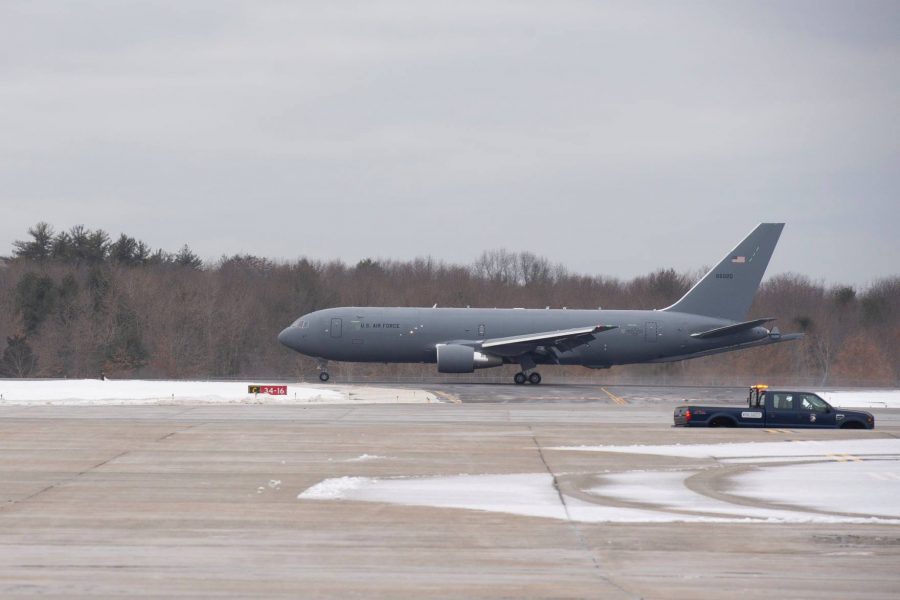Boeing missed planned KC-46 delivery dates in March and early April, leading to a slower than expected acceptance rate.
Despite this slow delivery rate, the head of U.S. Transportation Command told lawmakers on April 13 he is comfortable with the current aerial refueling capacity, noting there are more legacy tankers flying and the KC-46 could potentially begin flying limited operations this summer.
The Air Force accepted just two new tankers so far this year, significantly less than the two per month it had expected. There has not been a KC-46 delivery since early February, when Pease Air National Guard Base, N.H., received its 12th and final tanker. The Air Force Life Cycle Management Center said in an April 13 statement that subsequent deadlines passed without deliveries.
“Boeing has been unable to present aircraft in a delivery configuration to support planned/potential delivery dates for March and April,” AFLCMC said in a statement to Air Force Magazine. “The Program Office projects moderate risk for the next projected delivery on April 30th of one aircraft to Seymour Johnson [Air Force Base, N.C.].”
Air Mobility Command said earlier this year it has slowed the acceptance rate because the aircraft are not operational, and there’s a lack of qualified crews to fly them since pilots are sticking with legacy aircraft longer.
“As we bring them on, we’re going to do our due diligence at the different bases, but for right now, I don’t need to be in a hurry to take them at a faster rate than about two a month,” AMC boss Gen. Jacqueline D. Van Ovost said in early February.
Boeing delivered 14 tankers in all of 2020 due to the COVID-19 pandemic and other issues. The year before, the company delivered 28.
“We are working to deliver KC-46 aircraft at a pace that meets the needs of the U.S. Air Force,” Boeing said in a statement. “As we, along with our industry, continue to navigate through the pandemic, Boeing is aligned closely with the Air Force to deliver on our commitments.”
In October 2020, another KC-46 delivery slipped because of electrical issues on the plane, though the aircraft made it to Pease in November.
One year ago, U.S. Transportation Command publicly opposed the Air Force’s plan to retire legacy refueling tankers and said the mission is its most stressed. However, TRANSCOM Commander Gen. Stephen Lyons told the Senate Armed Services Committee the 2021 defense policy bill’s restriction on retiring KC-135s and KC-10s, coupled with Air Force steps to increase Guard and Reserve tanker capacity, means the command is in a “much better position.”
“I am comfortable, and aligned with the Air Force’s position on this,” Lyons said during an April 13 hearing. “Boeing has a long way to go to deliver a fully operational weapon system, but in the interim I’m confident in the day-to-day.”
USAF originally planned to retire at least 26 of the tankers in its budget request, and TRANSCOM asked Congress to buy back 23 of the planes to avoid a gap in its capability as the KC-46 comes on line.
The KC-46 program is in a better place, with the Air Force and Boeing agreeing on a way ahead to fix the aircraft’s remote vision system. The RVS 2.0 upgrade, with new cameras and other hardware, is expected to begin rolling out in 2023.
Air Mobility Command announced earlier this year that it will free up some KC-46s for limited operational missions—flying sorties in areas that it has been cleared for in testing such as refueling with its drogue system. TRANSCOM has said these missions could come as early as June. The tanker will not, however, be cleared for any combat missions in the short term.
During the April 13 hearing, Sen. Jeanne Shaheen (D-N.H.) said the KC-46’s galley and lavatory system has new problems, though Lyons said he was not aware of operational impacts. AMC in a statement said there is an issue with the roll-on Air Transportable Galley-Lavatory, not with the KC-46 itself. The system also is used on other mobility aircraft.
